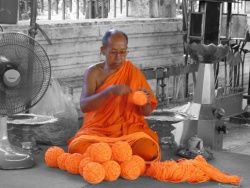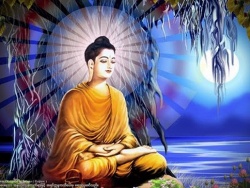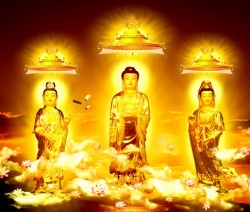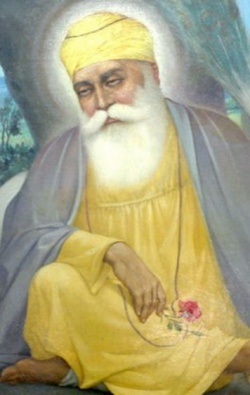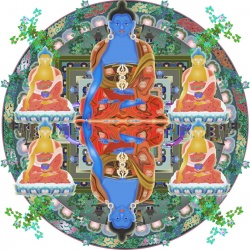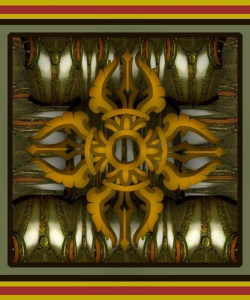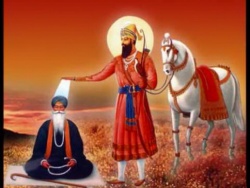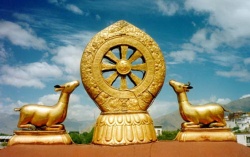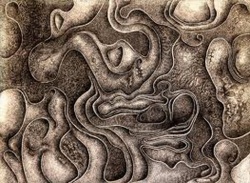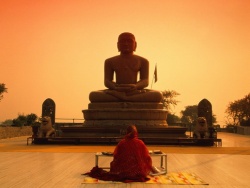A Complete and Detailed Exposition on the True Buddha Tantric Dharma
By Living Buddha Sheng-yen Lu
Translated by Janny Chow
The Mandala Offering
Today we will continue on with the fourth step of the liturgy, which is the Mandala Offering. In Tantrayana, eight kinds of offerings are set up on the tantric shrine. Five offerings are generally used in Buddhism. Of course, there are many other kinds of offerings, such as Seven, Twenty-One, Twenty-Two, Twenty-Seven, and Thirty-Seven Offerings, but we will concentrate here on the Five and Eight Offerings.
The Five Offerings are incense, flower, lamp, tea, and fruit, In the Eight Offerings there are, in addition to the five previously mentioned, powdered incense (which is the kind of incense that can be used for anointment), soapy water for bathing use, and a conch. These items, added to the Five Offerings, form the Eight Offerings.
Visualization
During the rite of offering, the Offering Mudra is formed [Grand Master demonstrates] and the Offering Mantra is changed to empower the offerings, "Om, sa-er-wa, da-ta-ga-da, ee-da-mook, gu-ru la-la, man-cha-la, kan, nee-lee-ye, da-ye-mee." While forming the Offering Mudra, one visualizes the offerings at the altar transforming first from one position to one whole row, then expanding to one field and, finally, filling up the whole Empty Space. This is as described in the offering verse that is often changed, "The Four Continents of Sumeru, sun, and moon, transform into precious treasures to offer to the Buddhas." After chanting the Offering Mantra, one then brings the Offering Mudra to the brow-point before releasing it.
Sometimes I am uncomfortable when people come up, in the presence of many others, to offer me the red envelopes (money offering) whether secretly or openly. Like yesterday, when I was sitting there, I waved my hands and told everyone that it was not necessary to make offerings to me. What I meant was that offerings are only required for empowerment. Since I did not give anyone an empowerment, I felt uneasy accepting offerings from everyone each time I gave a teaching. What I mean is, well, I don't really know what I mean. [audience laughter] In any case, I am embarrassed to take offerings in front of so many people without giving any empowerment. So perhaps, after today's session is over, I will see what kind of empowerment you would like to receive and we can have that done. This will be more meaningful, won't it?
The Meaning of Touching the Brow-Point
One might notice that, after I accept an offering, I bring it up to touch upon my brow-point. This resembles the motion when one brings the mudra to one's brow-point before releasing it. Does anyone know why? Some people suggest that this has to do with turning the offering over to the Buddhas, or transforming the offering through visualization into something else. In any case, some kind of turnover would be correct. [audience laughter] The monks and nuns, or masters here, have also had students make offerings to them, and they have also imitated the Grand Master in bringing the offerings to touch upon their brow-points, [audience laughter] as though checking if they have a fever or not. [audience laughter]
Actually, the real significance behind this act is: first, to honor and acknowledge the offering, since touching the brow-point signifies a kind of reverence; second, to emit from the brow-point the white, red, and blue lights to bless the person who makes the offering. This is performing purification, enhancement, magnetization, and subjugation for that person. In addition to the emitting of lights, when I lift the offering off my brow-point, I also visualize the offering or red envelope transforming into numbers of millions, to return the blessing to the person who makes the offering. Therefore one should not perform this motion arbitrarily, as all these meanings are implicit in it. [audience laughter] So, bring the offering to my brow-point is to indicate my reverence for it.
Therefore, when Kalu Rinpoche held up my photograph to touch upon his forehead, it meant: first, to show one's reverence; second, to emit lights from the brow-point onto the offering to perform purification, enhancement, magnetization, and subjugation for the donor; third, to visualize millions of red envelopes returning to the offerer. Remember this method of accepting offerings.
A Substantial Great Offering
The Great Offering we learn today consists of the empowerment of the offerings, with the Offering Mudra and Mantra, followed by the multiplication of the offerings by visualization before they are offered to the Buddhas and Bodhisattvas. In traditional Tantra, there was a Substantial Offering which required one to go and buy many substantial articles to offer to the Buddhas. If one wants to repent, to pour out all the troubles from one's heart to beseech the Buddhas for blessings, one needs to make a substantial Great Offering in order to get results.
Because of this many students made the substantial Great Offering the first time they visited their gurus. They would bring along different fabrics which could be tailored into Dharma robes, ceremonial robes, and daily wear for the gurus; they would offer delicious foods, money, and all kind of resources as well. In Tibet, in the past, students offered yaks, sheep, and produce from the mountains to their gurus. For example, a student would bring twenty yaks for learning a major practice and two yaks for a minor practice. Such were the rules.
Here I don't have any such rules. [audience laughter] If I told you a major transmission would require twenty yaks, and, if you brought them to me, I wouldn't know where to keep them! [audience laughter]
In Tibet, yaks and sheep were the resources, whereas here at the Grand Master's, American dollars are the resources! [audience laughter]
There is, however, absolutely no rule here as to how much one should offer to the guru. This is because my guru told me, and I have passed down the rule, that students should make offerings as they please.
If I fixed a set price for anything, I would be breaking the precepts given to me by my guru - the Taoist Master Ching Chen, who was also known as the Monk Liao Ming. He told me that, when the day came for me to go down the mountain and practice my skills in the world [audience laughter], I must bear in mind that I could not set a price for anything, be it a deliverance or blessing ceremony, the placing of name plaques or the lighting of lamps in the temples. It is a rule from my guru that people can pay me whatever they please for my help. I have always abided by this rule.
Therefore, I will comply with someone's wishes even though he only sends me two Malaysian dollars and requests the installment of a lamp at the lamp pagoda, a petition for guidance and protection at the shrine of the year's Planetary Ruler, a plaque for his deceased ancestors, and registration for the upcoming blessing and bardo deliverance ceremonies -- with whatever that is leftover from the two dollars to be used as an offering for the Grand Master. [audience uproar of laughter] Do you know that Master Lian Huo and Master Lian Shi who are seated here, have the plaques made in Taiwan and the cost of each plaque is twenty U.S. dollars? I know that two Malaysian dollars can be quite useful in Malaysia, as one bowl of noodles there costs only one dollar, so two dollars can purchase two meals. However, one needs to do a little computation and prevent the Lei Tsang Temple [Ling Shen Ching Tze Temple) from losing money. [audience laughter] This is extraneous talk [not really pertaining to the True Buddha Liturgy.]
The Infinite Merits of Great Offerings
Generally speaking, an offering that is made or transformed with devotion from one's heart is excellent. The idea behind a Great Offering is to set up a sumptuous feast as an offering to the Buddhas and Bodhisattvas that they will be moved to bestow blessings in return. For instance, in the past, when Tsongkhapa made a supplication to ask Bodhisattva Manjusri to teach him the Dharma, he had prepared a bountiful selection of the best and most expensive kinds of fabrics, flowers, and foods. In front of the image of the Bodhisattva, he set up a Great Offering to display and offer all his selections. During his Dharma practice, Bodhisattva Manjusri appeared to him at his shrine. According to Tsongkhapa's description, the kind of light emanating from Bodhisattva Manjusri resembled rainbow colored cotton fibers, which formed a huge and thickly dotted circle of light with Bodhisattva Manjusri in the middle. Tsongkhapa saw the Bodhisattva during his Dharma practice, and this is an excellent example of the phenomenon of spiritual response.
This example is an illustration of the effect of a Great Offering. Now it seems that, within our True Buddha School, one does not see too many examples of such Great Offerings; most people bring only one small item when they come to do group cultivation at 8 p.m. each Saturday. After each group cultivation at the Lei Tsang Temple, which has about the same number of participants as we have here today, I would notice people going to drink some Great Compassion Dharani Water [audience laughter] after the Master has finished energizing the water, but I usually would not see anyone make a Great Offering, or even offer a piece of cake or some cookies. The fruits on the tables had been there many days and were almost rotten. Most people brought along some fruit as offerings and, after worshiping, they would return home with most of their fruit, leaving a couple of smaller pieces behind. These, they say are for the staff at the Temple. [audience laughter] These fruits would remain for many days until almost rotten.
One must make offerings to the Buddhas and Bodhisattvas wholeheartedly. When one purchases the offerings with a devoted heart and displays all of them in front of the Buddhas, it is a Great Offering. When one generates a genuine pleasure in making the offerings, the Buddhas and Bodhisattvas will take a genuine pleasure in receiving them and will bestow blessings upon one. The practice of offerings is a necessary element and is found in many other religions. When one is making a special supplication for a certain wish to be granted, one must make a Great Offering.
On the other hand, there is the Transformed Offering. Instead of making a Great Offering, most of the True Buddha School students today have learned to do the Transformed Offering by visualizing one small item multiplying into many. [audience laughter] Well, this is acceptable as, in our school, one must learn to perform this kind of visualization. As an example, one can transform a single apple into a row of apples, then further multiply them to form a whole field of apples, until the whole spiritual realm is filled with apples. There will be so many apples that their consumption will never be exhausted. This is a Tantric visualization. One may do this visualization and then chant the Offering Mantra to empower the offerings.
Appropriate Offerings
Many people have wondered if some things are more appropriate than others as offerings. One knows that offerings made to the Four Heavenly Kings (Deva Kings), the Yellow, Black, Red, and White Jambhalas, the Wealth Deities of the Five Directions, and the Treasure Deva King should include wine. Also, the White Jambhala likes bath water, so one should make a bath water offering. In general, one should find out what kind of things the Deities or Dharma Protectors like and offer those things to them.
What should one offer to the Buddhas and Bodhisattvas? Instead of offering what the Buddhas like, one offers what one likes to the Buddhas. According to Tantric teachings, the Buddhas and Bodhisattvas have no desires or aversions, and their minds are always kept in a balanced state of equanimity. In other words, there is nothing that the Buddhas particularly favor or disfavor and, therefore, they will not like or dislike anything that one offers. It would be proper then to offer to the Buddhas what one personally likes. When one offers to the gods according to their desires, they will be happy and bestow blessings upon one. When one offers what one likes most to the Buddhas, the Buddhas will take delight in the pleasure sprouted in one's heart and, when the two intents meet, there will be a spiritual response.
In Taiwan, many people used to worship "child spirits." To my understanding, one could make offerings of marbles, rubber bands, and playing cards to these spirits because, when they were children in the human world, they enjoyed such games. Therefore, offering things that simply pleased these "child spirits" would bring results.
However, children today are different: they play computer games. [audience laughter] Therefore, if one offers children a television and some games, they will sit in front of the television and play the computer games and become totally absorbed. So, in a way, it is true that there is a greater chance of meeting each other when one does what the other party likes to do.
In one downtown area of Thailand there is a shrine to the Brahma Deva. It is a god with four faces and I can't recall whether he has six or eight arms. Anyway, it is known that this god enjoys watching women dancing. Therefore, many women go to pray to this god, make a wish, and vow that they will dance in front of this god when their wish is fulfilled. In this case, it is offering something which the Deva likes in order to get one's wish fulfilled.
Thus one has to remember that one offers what the Dharma Protector likes to the Dharma Protected. One offers to the Buddhas and Bodhisattvas what pleases one in one's own heart, in order to achieve a yogic response. In the past, in Tibet, the Rite of Offering required one to hold some rice grains in the palm and then these rice grains were visualized to undergo a transformation into all kinds of treasures that, when they were scattered at the end of the offering, filled up the whole universe. Rice was used because Tibetans considered rice to be very valuable. They also used rice during consecration ceremonies in which the rice, a symbol for Light, would be sprinkled.
Now rice is quite an ordinary item to us; therefore, we don't have to limit ourselves to this one offering. And if we do use rice, we can, at the time of scattering, perform visualization to transform the rice into thousands of other kinds of items. This is a very important point.
Offerings As Resources
Actually there is another meaning to Great Offering. To make an offering is to provide "resources," not for the Buddhas, but for oneself. If one wishes to have sufficient resources to support oneself on the path of cultivation, one must learn to make the Great Offering or Mandala Offering. Through the Great Offering, one beseeches the Buddhas and Bodhisattvas to bestow food and resources, so that one can easily and peacefully engage in cultivation. After a true cultivator learns how to do the Great Offering properly, the Buddhas and Bodhisattvas will bestow blessings upon one, and benefactors will automatically appear to offer resources. If one desires to do a long-term retreat and lacks sufficient funds, one can make a Great Offering in front of the Buddhas and Bodhisattvas and state one's intent. Benefactors will then naturally recognize one's needs and provide food and money, so that one can do spiritual cultivation without any material worry. In ancient times, many great Adepts made Great Offerings in front of the Buddhas and Bodhisattvas and, later, they met benefactors who materially supported their practice.
Financial Resources
Four conditions have been found to be indispensable in modern day Tantric cultivation. In ancient times, many Adepts did not have to meet these prerequisites because they practiced asceticism. However, nowadays one needs these four conditions. First, is financial resources. Many items needed for Tantric practice are very expensive. For example, the three statues [at the shrine at Rainbow Villa] of Buddha Shakyamuni, Medicine Buddha, and Amitabha Buddha, cost twenty thousand U.S. dollars apiece. If one cannot afford these statues, how can one set up the shrine? Many of the Tantric ritual implements are made of gold or silver, followed by copper, steel, porcelain, and ceramic, in descending order of suitability. The mala [rosary], vajra and bell, one-pointed vajra, damaru drum, Dharma seat, and other adornments for the shrine cannot be obtained without money. Even the preparation of a Great Offering needs money. Therefore, the first condition is sufficient material resources.
Spiritual Partners
The second condition is to have spiritual partners. What are spiritual partners? They are fellow spiritual cultivators. When one cultivates alone and gropes around by oneself, without any help from people who can provide the right kind of knowledge, it is very difficult to obtain the True Wisdom. One needs true spiritual partners who are also totally devoted to the pursuit of the Buddhadharma. This way, there will be an exchange of knowledge and a sharing of experiences which will enable one to quickly attain spiritual maturity.
It is not always possible to obtain spiritual partners. What if, every time a husband meditates, the wife pours a bucket of water over his head, [audience laughter] or she goes to the freezer to get some ice cubes to slip down his collar? Such examples illustrate circumstances where the condition of spiritual partners is not being met.
Therefore, it makes a significant difference if one has a spiritual partner who is also pursuing the same goal and able to study and exchange ideas with one. This can be an ideal situation.
Dharma
The third condition is Dharma, the method of cultivation. Even if one has the financial resources and the right spiritual partner, one still needs the authentic Buddhadharma. Therefore, one needs to find a true teacher who knows the Buddhadharma, who has already gone through the Path and can teach one to walk on the same path to reach Buddhahood. This is a very important condition because only the teacher can impart the proper method and technique to enable one to reach Enlightenment.
The Practice Site
The site of cultivation is also very important. The land that Rainbow Villa sits on is a site of great energy. If one practices at a site that has too many people living together, the geomancy is bad, the energy (from the earth) is low, the environment is complicated, and neighbors could well complain each time one lights an incense, then it is not a good practice site. Without a good environment, a good geomancy, and good neighbor relations, the condition of a quiet and powerful site is not being met.
An Eternal Blessing
How does one secure these four indispensable supports of financial resources, spiritual partners, Dharma, and site? By making offerings. If one knows how to make Great Offering, these four conditions will arise. If one does not know how to or chooses to neglect making offerings, one will have difficulties in securing these conditions. I have made so many Great Offerings in this lifetime that I can choose, if I wan to, to be born in my next life as a king. This is one way I could keep on helping to liberate sentient beings. A king is very rich! Why am I so confident that I will surely be born as a king in my next lifetime? Because I have learned to make the true kind of offering in this life time. I have learned to make offerings with my whose heart and beings, and I can transform all my offerings into treasures as vast as those of the devas'. When one is in possession of such wealth, one can acquire a vast land, gather spiritual partners from among the vast population of sentient beings, and rule with the great number of Dharma practices. When one becomes a king, financial resources, spiritual partners, Dharmas, and sites of power within the county will all be accessible to him.
In spiritual cultivation, if one truly learns to make the Great Offerings, one can become a king in a future life. Many Buddhist monks and Tantric masters know how to make Great Offerings to Buddhas and Bodhisattvas. In fact, many kings and presidents in the world were once monks who made Great Offerings in their previous lives.
I hope you will learn to do the Great Offerings well and will be able to obtain sufficient resources for doing cultivation in this life. In your next life, you could become a wealthy person or be born into the families of the Deva Kings. Or, with more resources accumulated, you might even become a Treasure Deva king. Therefore, the practice of the Great Offering is very important. I have divulged the main idea behind the practice of Great Offering, which is: when offerings are made to the Buddhas and Bodhisattvas, and these offerings cause delight, they will bestow blessings and resources (money, partners, Dharmas, and sites) to help facilitate one's spiritual cultivation. [Grand Master rings the bell.]
